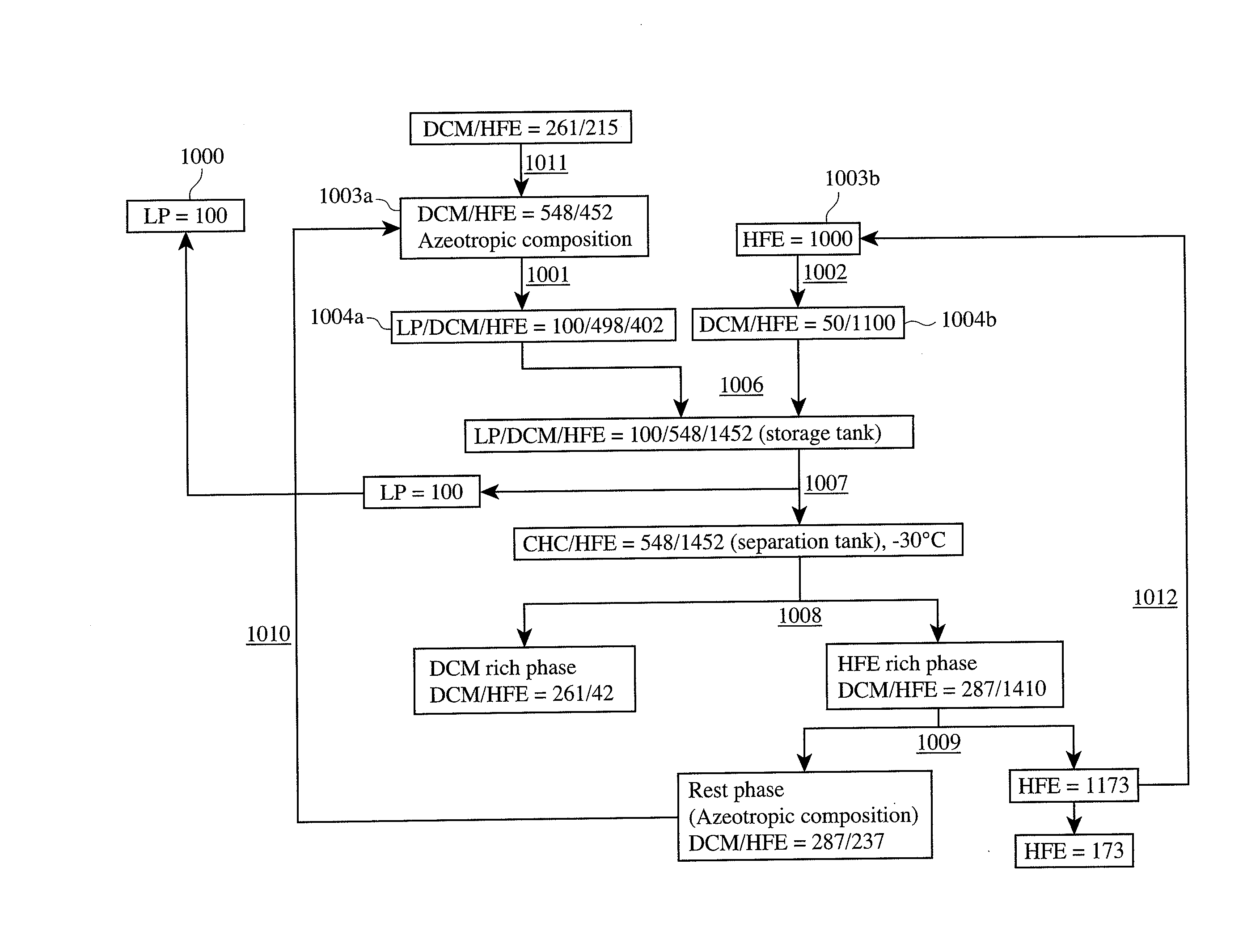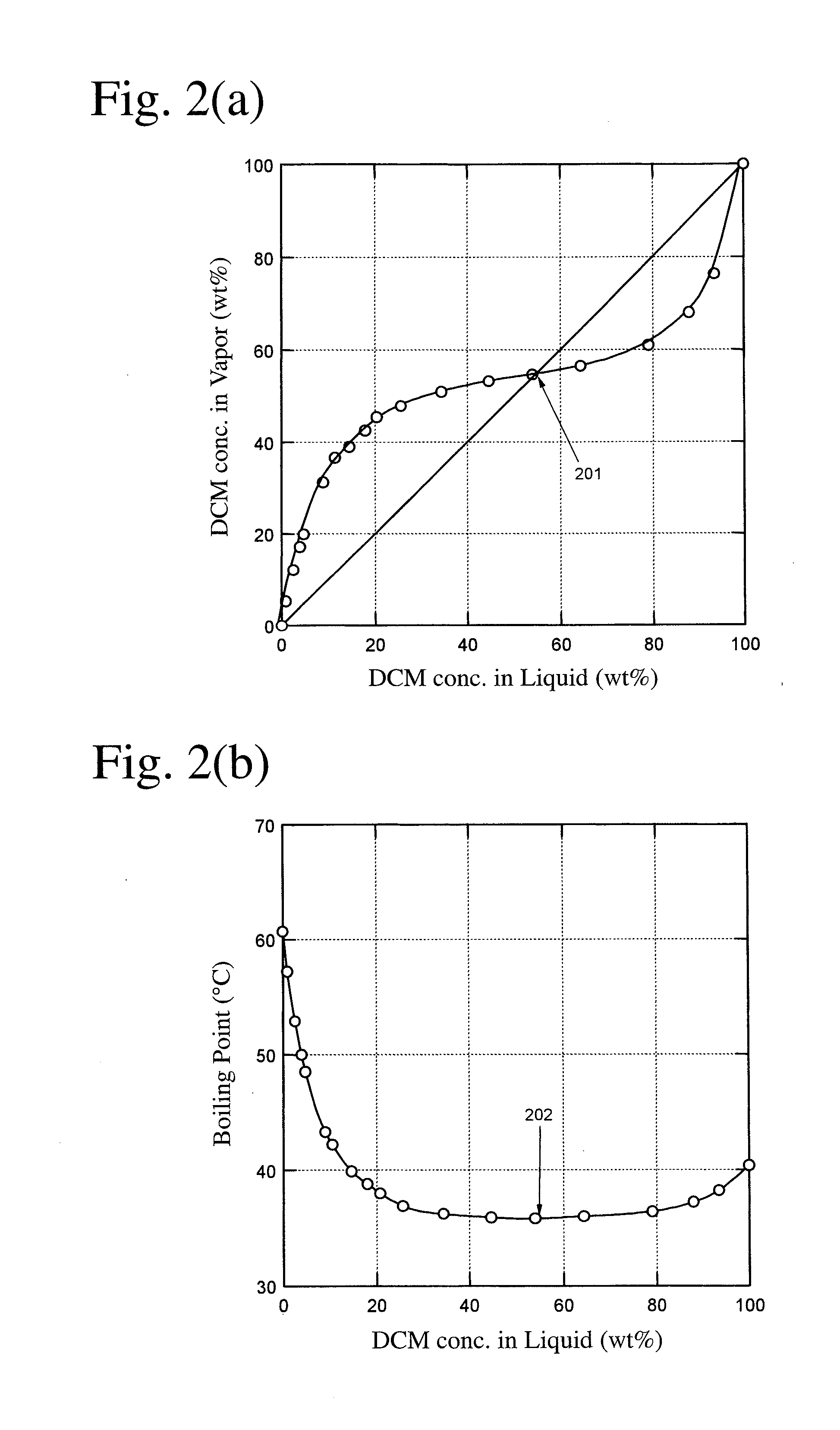Method for removing diluent from a polymer extrudate, and its applications
- Summary
- Abstract
- Description
- Claims
- Application Information
AI Technical Summary
Benefits of technology
Problems solved by technology
Method used
Image
Examples
example 1
[0140]FIG. 9 schematically shows the amount of DCM and HFE in the process steps described above in connection with the Ninth Method. Liquid paraffin (LP) (900) was used as a process solvent, DCM was used as CHC, and C4F9OCH3 was used as HFE. Polymer extrudate containing LP was conducted to step (A) for LP removal (901). In step (A), a washing solvent (903a) comprised of 1100 wt. parts of DCM and 100 wt. parts of C4F9OCH3, based on 100 wt. parts of LP. Hereinafter, when using “wt. parts”, all of “wt. parts” is based on 100 wt. parts of LP. In other words, the washing solvent was consisted of 92 wt. % of DCM and 8 wt. % of C4F9OCH3, based on the total amount of the washing solvent. After conducting the polymer extrudate to step (A), the washed polymer extrudate was conducted to a rinsing stage where the washed extrudate was rinsed with a rinsing solvent comprising 800 wt. parts of HFE, based on 100 wt. parts of LP (902). After conducting the polymer extrudate to step (B), a combined e...
example 2
[0143]FIG. 10 also schematically shows the amount of DCM and HFE in the process steps. In this example, liquid paraffin (LP) was used as a process solvent (1000), DCM was used as CHC, and C4F9OCH3 was used as HFE. In this example, a purified C4F9OCH3 and an azeotropic composition of DCM and C4F9OCH3 was obtained by conducting azeotropic distillation of the HFE-rich phase, and purified HFE was recycled for re-use. The purified C4F9OCH3 was reused as a rinsing solvent, and the azeotropic composition of DCM and C4F9OCH3 was reused as a washing solvent.
[0144]Polymer extrudate containing LP was conducted to step (A) (1001). In this example, the washing solvent was an azeotropic composition of DCM and C4F9OCH3 and the rinsing solvent was C4F9OCH3. The azeotropic composition contained 548 wt. parts of DCM and 452 wt. parts of C4F9OCH3. The rinsing solvent was 1000 wt. parts HFE, i.e., it contained relatively pure HFE. After conducting the polymer extrudate to step (A), the washed polymer e...
example 3
[0147]This example describes the continuous production of a microporous membrane using one of the solvent recycle aspects of the invention. 99.625 weight parts of a polyethylene (PE) composition comprising 30 wt. % of ultra-high-molecular-weight polyethylene (UHMWPE) having a weight-average molecular weight (Mw) of 3.0×106, and 70 wt. % of high-density polyethylene (HDPE) having Mw of 3.3×105, were dry-blended with 0.375 parts by mass of tetrakis[methylene-3-(3,5-ditertiary-butyl-4-hydroxyphenyl)-propionate] methane as an antioxidant.
[0148]20 wt. parts of the resultant mixture was charged into a strong-blending double-screw extruder having an inner diameter of 58 mm and L / D of 52.5, and 80 wt. parts of liquid paraffin (50 cst at 40° C.) was supplied to the double-screw extruder via a side feeder. Melt-blending was conducted at 230° C. and 250 rpm to prepare a polyethylene solution. The polyethylene solution was extruded from a T-die mounted to a tip end of the double-screw extruder,...
PUM
| Property | Measurement | Unit |
|---|---|---|
| Temperature | aaaaa | aaaaa |
| Time | aaaaa | aaaaa |
| Composition | aaaaa | aaaaa |
Abstract
Description
Claims
Application Information
 Login to view more
Login to view more - R&D Engineer
- R&D Manager
- IP Professional
- Industry Leading Data Capabilities
- Powerful AI technology
- Patent DNA Extraction
Browse by: Latest US Patents, China's latest patents, Technical Efficacy Thesaurus, Application Domain, Technology Topic.
© 2024 PatSnap. All rights reserved.Legal|Privacy policy|Modern Slavery Act Transparency Statement|Sitemap



